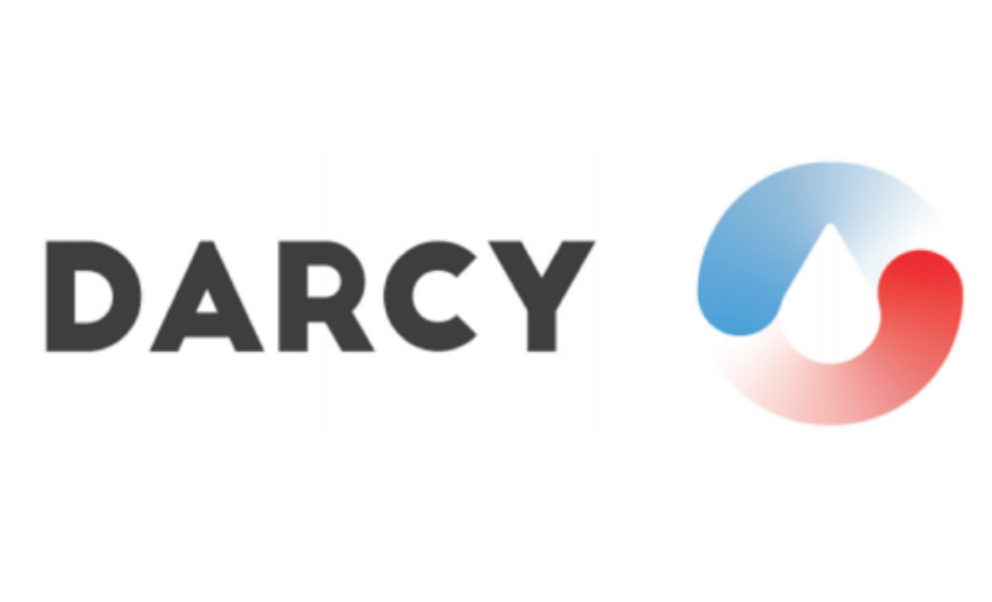
It’s been a hot summer.
 The temperature in Chicago has been hovering around 90 for the past few weeks. Humid, too. With beaches and pools closed due to the pandemic, it’s hard to find ways to cool down. Meanwhile, my A/C unit (for which I am extraordinarily grateful) struggles to keep up with the oppressive heat as my electric bill goes through the roof. And that’s just me. There must be A LOT of AC units out there using A LOT of energy to keep A LOT of people comfortable. Is there a better way to do this?
The temperature in Chicago has been hovering around 90 for the past few weeks. Humid, too. With beaches and pools closed due to the pandemic, it’s hard to find ways to cool down. Meanwhile, my A/C unit (for which I am extraordinarily grateful) struggles to keep up with the oppressive heat as my electric bill goes through the roof. And that’s just me. There must be A LOT of AC units out there using A LOT of energy to keep A LOT of people comfortable. Is there a better way to do this?
Darcy + CET
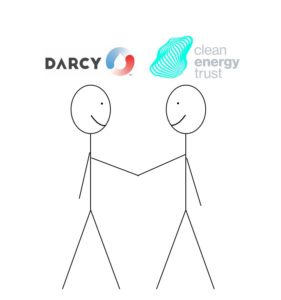 Last year, Clean Energy Trust became the very first investor in Darcy Solutions, a startup based in the Twin Cities, spinning out of the University of Minnesota. The very first investor, eh? Sounds risky. They must have some very special technology, right? Yes and yes — just the way we like it! So what’s so special about this technology? Well, it will dramatically lower the cost of heating and cooling buildings using renewable geothermal energy and a mere trickle of electricity. But before we dig into Darcy’s innovation, let’s get on the same page.
Last year, Clean Energy Trust became the very first investor in Darcy Solutions, a startup based in the Twin Cities, spinning out of the University of Minnesota. The very first investor, eh? Sounds risky. They must have some very special technology, right? Yes and yes — just the way we like it! So what’s so special about this technology? Well, it will dramatically lower the cost of heating and cooling buildings using renewable geothermal energy and a mere trickle of electricity. But before we dig into Darcy’s innovation, let’s get on the same page.
Geothermal energy: a quick primer
The term “geothermal renewable energy” can mean different things, but in general, it refers to thermal energy that is extracted from below the Earth’s surface. There are predominantly two types of geothermal energy. The first type — let’s call it “geothermal power” — exploits pockets of extreme thermal activity far beneath the Earth’s surface (2–6 miles), where temperatures can be as high as 600°F, to spin a large turbine to generate utility-scale power. The second type — “geothermal heating and cooling” — uses the consistently 60°F temperature just below the Earth’s surface (150–300 feet) to heat and cool buildings using a heat pump.
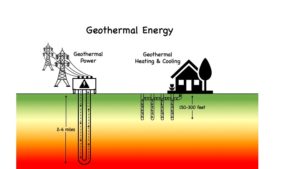
Wait — what’s a heat pump?
Simply put, heat pumps use electricity to move heat from a cool space to a warm space using a vapor compression cycle (like a refrigerator). They can replace both a furnace/boiler and a traditional A/C unit or chiller/cooling tower, and they’re much more efficient. In the summer, they move heat from inside a building to the outside. In the winter, they move heat from outside into a building (remember, even when it’s really cold out, “heat” — i.e. thermal energy — is still present). Pretty cool! Heat pumps are generally more expensive than a single furnace or A/C unit, but the costs have been coming down and the total cost of ownership is often lower than the typical options.
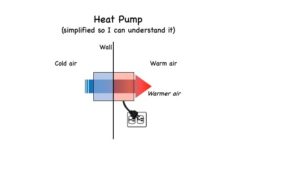
There are two primary types of heat pumps: air source heat pumps (ASHP) and ground source heat pumps (GSHP). ASHP extract heat from the air while GSHP extract heat from the ground. ASHP are relatively affordable, quite efficient, and easy to install. However, they do struggle to keep up in extreme cold. GSHP are 2–3x more efficient than ASHP, can perform in extreme conditions, and can even provide domestic hot water (bonus!).
But the downside is the very high installation cost, driven by the need to drill several boreholes to run the heat exchange loops. The rule of thumb is one loop per ton of heating/cooling capacity. And each borehole will cost ~$10k to drill. A typical home may require a 3–5 ton system while a small commercial building may require a 10–20 ton system.
As you can see, the upfront drilling costs can be a deal-breaker despite the extraordinary efficiency. The system will eventually pay for itself, but it’s tough to shell out that much cash. Financing options can help address this issue, but the total cost is still high and there will always be logistical challenges from having to drill so many boreholes.
More info on heat pumps can be found here.
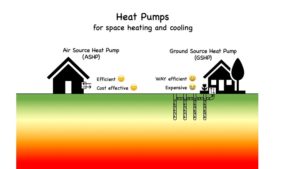
Ok, so now that we’re on the same page, let’s focus on GSHP/geothermal heating and cooling. Remarkably efficient (WOOT WOOT!), but very expensive to install (womp womp…). And the big problem is the cost of drilling. So, if you want to make GSHP more affordable, you could either figure out a way to make drilling less expensive, or you could figure out a way to do less drilling.
Darcy to the rescue!
Ultimately, the amount of drilling required for a GSHP is a function of heat exchange efficiency. The team at Darcy Solutions came up with a very simple, elegant solution to increase heat exchange efficiency by more than 10x.
Rather than extracting heat from the ground via conductive heat transfer, they developed a proprietary heat exchanger that extracts heat from groundwater via convective heat transfer. (Note: this is a closed-loop system. No water is extracted from the aquifer; the groundwater is merely used to warm or cool the loop).
The result is 10 tons of heating/cooling capacity per loop instead of only 1 ton, which translates to up to 50% lower installation cost than a traditional GSHP system. And with fewer loops to operate, Darcy’s system is also 20% cheaper to operate than traditional GSHP. They are currently testing an in-field pilot system and the results are extremely promising.
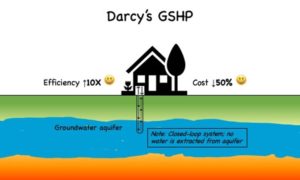
Cooling is just heating up
Setting aside heating for a moment, let’s just take a look at air conditioning. Like I said, it’s been a hot summer. There are more than 1.6 billion air conditioning units globally today that demand approximately 2 terawatt-hours of energy per year, and as developing nations industrialize and the planet continues to warm, the global population of A/C units is expected to balloon to 5.6 billion by 2050, requiring more than 6 terawatt-hours to operate, as reported in The Future of Cooling, a fascinating IEA report.
Let’s put that in perspective.
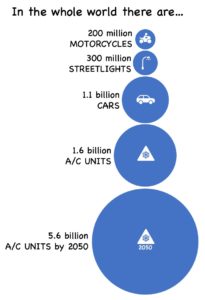
Big problem, big impact
Buildings account for about 40% of today’s greenhouse gas emissions, and space/water heating and cooling is by far a building’s biggest energy hog. Considering the growth forecast for A/C, it’s clear we are on an unsustainable path.
We need to invest in energy efficiency, electrification, and decarbonization of the electric sector. Darcy’s novel approach makes GSHP affordable and the potential impact is massive — especially if coupled with solar or some other zero-carbon electricity source.
Based on internal analysis at Clean Energy Trust, we estimate that Darcy’s solution could offset greenhouse gas emissions by more than a gigaton of CO2 per year when deployed at scale.
This impact is equivalent to taking about 200 million cars off the road. Unfortunately, I don’t have sufficient resolution or screen real estate to visually depict this equivalence, so let’s try another comparison: coal power plants.
Deployed at scale, Darcy’s emissions reduction potential is equivalent to retiring 250 coal-fired power plants (based on data and calculations from the EPA).
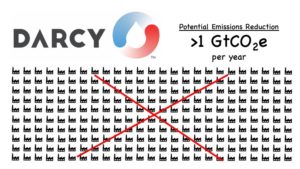
Let’s call it a day, but please keep this in mind
When you turn on your A/C this summer (and your heat this coming fall and winter), remember this little startup in Minnesota you just learned about — Darcy Solutions — that developed a cost-effective way to keep us all comfortable. And if one day we were all using this ultra-efficient system, we will have effectively pulled the plug on 250 coal-fired power plants, mitigating roughly 6,040,061,978 pounds of CO2 each and every day.
. . .
Special thanks
I borrowed Tim Urban’s blogging style for this post. If you don’t read his stuff, you should. Check out Wait But Why and follow Tim @waitbutwhy. Thanks, Tim!
And follow me @mediumpauly
Read more of our news and perspectives on Medium.


